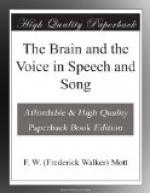In 1863 Broca showed the importance in all right-handed people (that is in about ninety-five per cent of all human beings) of the third left frontal convolution for speech (vide figs. 16 and 17); when this is destroyed by disease, although the patient can understand what is said and can understand written and printed language, the power of articulate speech is lost. Motor Aphasia. This portion of the brain is concerned with the revival of the motor images, and has been termed by Dr. Bastian “the glosso-kinaesthetic centre,” or the cortical grey matter, in which the images of the sense of movement of the lips and tongue are formed (vide fig. 17). A destruction of a similar portion of the cortex in a right-handed person produces no loss of speech; but if the person is left-handed there is aphasia, because he, being left-handed, uses the third right inferior frontal convolution for speech. These facts have for long been accepted by most neurologists, but recently doubts have been cast upon this fundamental principle of cerebral localisation by a most distinguished French neurologist, M. Marie; he has pointed out that a destructive lesion of the cortex may be accompanied by subcortical damage, which interrupts fibres coming from other parts of the brain connected with speech.
In the study of speech defects it is useful to employ a diagram; a certain part of the brain corresponds to the Speech Zone there indicated, and lesions injuring any part of this area in the left hemisphere cause speech defects (vide fig. 17). All neurologists, M. Marie included, admit this, and the whole question therefore is: Is a destruction of certain limited regions of the superficial grey matter the cause of different forms of speech defects, or are they not due more to the destruction of subcortical systems of fibres, which lie beneath this cortical speech zone?
There is a certain portion of the speech zone which is assumed to be connected with the revival of written or printed language, and is called the visual word-centre. There is another region connected with the memory of spoken words—the auditory word-centre; you will observe that it is situated in the posterior third of the first temporal convolution, but this does not comprise nearly the whole of it, for there is an extensive surface of grey matter lying unseen within the fissure, called the transverse convolutions, or gyri. Lesions of either of these regions give rise to Sensory Aphasia, which means a loss of speech due to inability to revive in memory the articulate sounds which serve as verbal symbols, or the graphic signs which serve as visual symbols for language.
[Illustration: FIG. 17]




